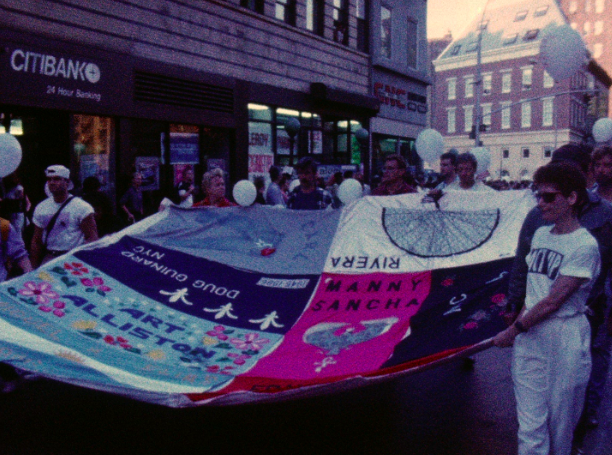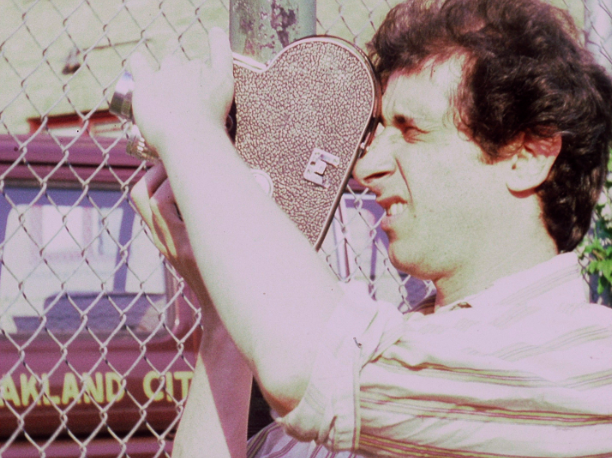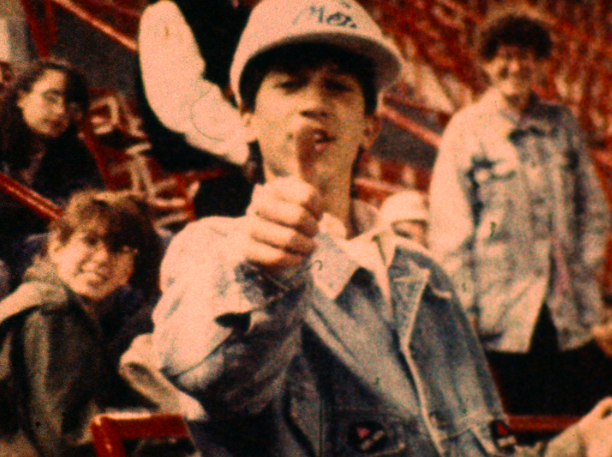ELEGY IN THE STREETS (US, 1989, Jim Hubbard)
/Curator Jon Gartenberg writes that “ELEGY IN THE STREETS was shot by filmmaker Jim Hubbard during the height of the Reagan Presidency, when both Reagan and his political administration ignored the deadly disease that afflicted an endless parade of human beings who ultimately died of AIDS. Hubbard’s film is replete with imagery associated with this era, including Gay Pride marches, candlelight vigils, ACT UP demonstrations, T-shirts embossed with bloody hands, cardboard headstones, police arrests, and the American flag hung upside down. As such, this movie can be viewed as a counterculture tract, a political protest film, an experimental documentary, and a diary film about Hubbard’s deceased partner and fellow filmmaker Roger Jacoby.
STILL: ELEGY IN THE STREETS (1989). SOURCE: JIM HUBBARD.
On a formal level, ELEGY IN THE STREETS is a stunning visual poem about erasure. Hubbard’s film is replete with iconography that reinforces the concept of disappearance. Individuals wearing T-shirts and holding banners are emblazoned with the phrases FIGHTING FOR OUR LIVES and SILENCE=DEATH. Posters featuring Ronald Reagan’s face symbolize the U.S. government’s muted response to this acute national and global health crisis. Individual names of the fallen are written In Memoriam on white balloons. Massive amounts of red and white balloons are released into the heavens; they symbolize the battle between red blood cells that provide oxygen to the body with white blood cells that fight infections such as HIV. The field of lit candles in the dark during the vigil for the fallen is a reminder that each one of these flickering flames, too, will eventually burn out and die.
FILMMAKER ROGER JACOBY WITH 16mm BOLEX CAMERA, IN ELEGY IN THE STREETS. SOURCE: JIM HUBBARD.
Hubbard employs a myriad of technical tropes in the experimental vein to complement these overarching visual motifs that signify erasure. With the filmmaker’s focus on the changing of exposures, the battle between light and darkness prevails. Human figures shot on positive reversal film stock are transformed into their ghostly opposite by appearing as almost skeletal-like in negative. Hubbard’s hand processing of his movie results in overlays of different-hued color palettes, which serve to obscure the photographic imagery embedded on the surface emulsion of the film. The materiality of the 16mm film stock, comprising flares and leader, also make ephemeral what had previously been seen.
As fellow filmmaker Jeanne Liotta has so eloquently written about Hubbard’s movie, ‘The latency of the photographic images meld with the ghost of our dead comrades, as they oscillate exquisitely between positive and negative spaces, a queering of the film emulsion in a rebellious glow of beauty and sorrow.’”
STILL: ELEGY IN THE STREETS (1989). SOURCE: JIM HUBBARD.
ELEGY IN THE STREETS is a silent film, a choice Hubbard made “ for several crucial reasons. First, it is a literalization of the phrase ‘Silence = Death.’ Second, I live in New York City, a very loud place to live and, for me, silence is a great luxury. Third, I believe that film is a visual medium and sound is typically used to manipulate and limit the emotional response of the audience. I want each member of the audience to experience the film uniquely and personally. Silence forces the viewer to really look at what there is to see.”
Hubbard’s film remains a moving and salient historical artifact, presenting key early footage of AIDS activist projects and demonstrations in New York City. Furthermore, in a period dominated by video — wherein the vast majority of footage chronicling AIDS marches were documented in this medium — ELEGY IN THE STREETS is notable for being shot entirely on 16mm.
ELEGY IN THE STREETS
(US, 1989)
Director: Jim Hubbard
- 28 minutes
- 16mm
- Color
- Silent
Distribution Format/s: DSL/Downloadable 1080p .mp4 file on server
Published By: GME
Institutional Price: $250
To order call: 212.280.8654 or click here for information on ordering by fax, e-mail or post.






